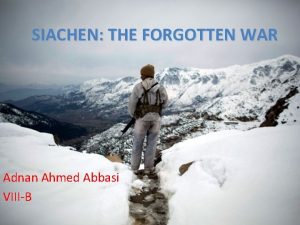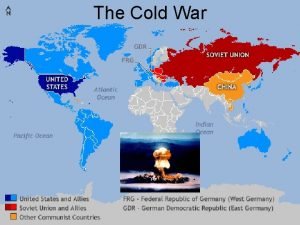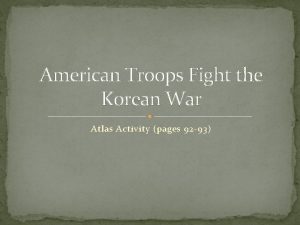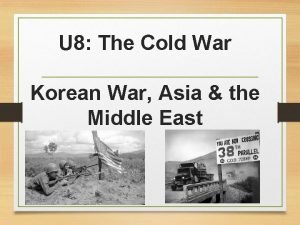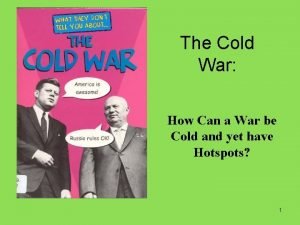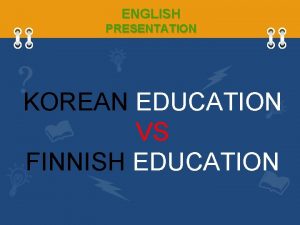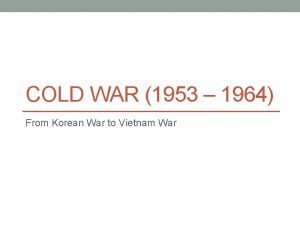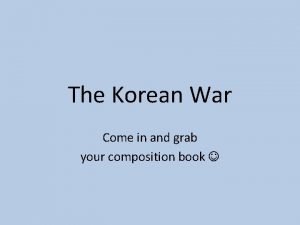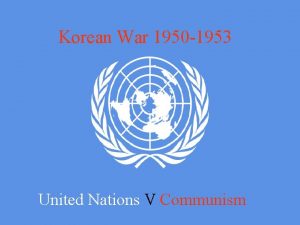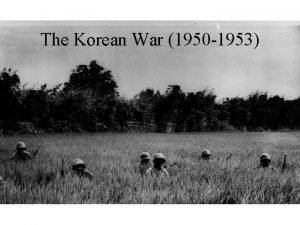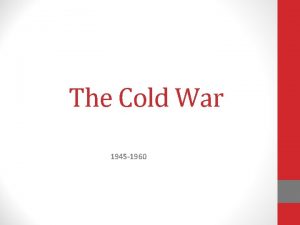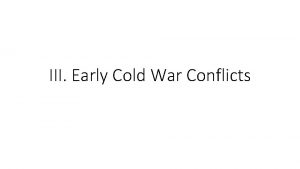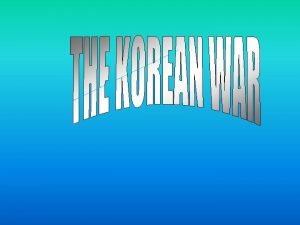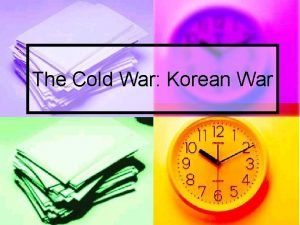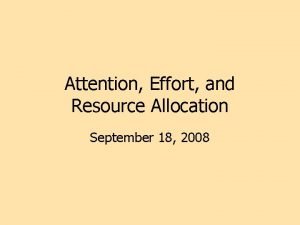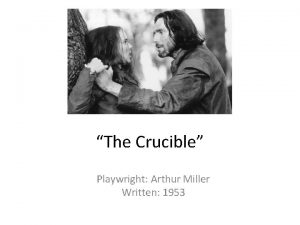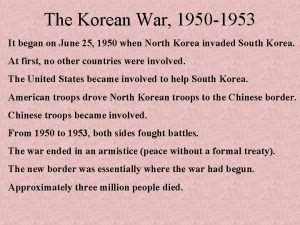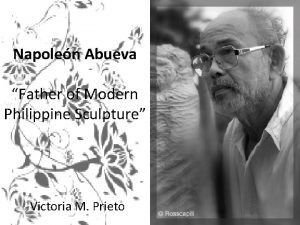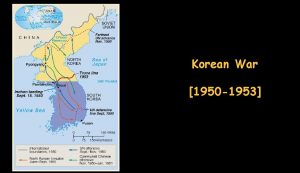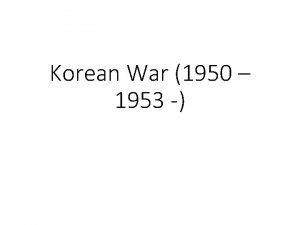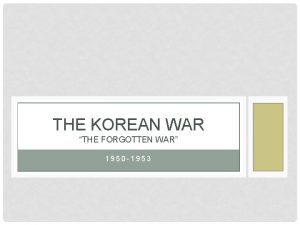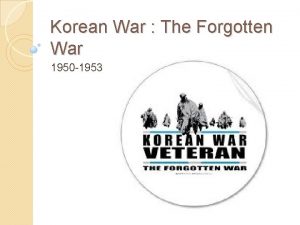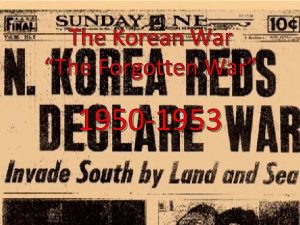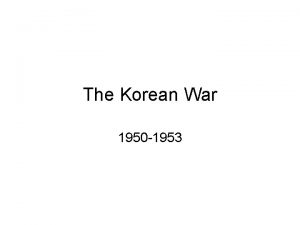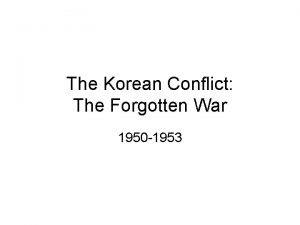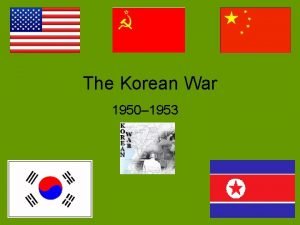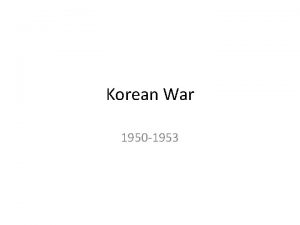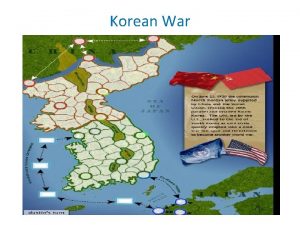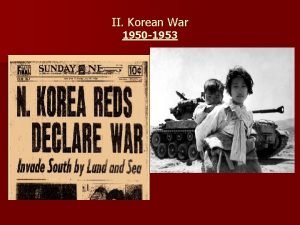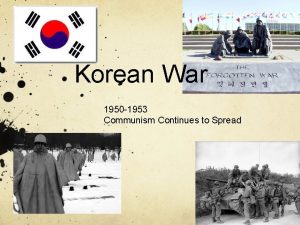THE KOREAN WAR 1950 1953 The Forgotten War


























- Slides: 26

THE KOREAN WAR 1950 -1953 “The Forgotten War”

Canadian foreign policy after the Second World War Canadians had a fear of totalitarian governments and a distrust of the Soviet Union Cooperation and solidarity with Great Britain and the US was critical Canadian foreign policy was centered on Western Europe: limiting the threat or expansion of totalitarian regimes, namely Communism As a middle power, if our foreign policy was to have force we would need to join with other democracies; this is one of the reasons we joined NATO

Causes of the Korean War Up until 1945, Korea was controlled by Japan When Japan surrendered in August 1945, control of Korea was given to two countries: the USSR (North Korea) and the US (South Korea) The division between North and South was at the 38 th parallel It was assumed that occupation would be temporary and the country would soon become a unified,

Who should govern the country? The 38 th parallel soon became a permanent boundary as tensions between democracy and communism flared during the Cold War USSR established a communist government and supplied it with weapons USA established a democratic government The US wanted the UN to solve the issue USSR wanted both sides to withdraw and leave the Koreans free to choose their own government

In November 1947, the UN established a temporary commission to supervise free and secret elections The Soviet Union denied access to North Korea August 1948: Republic of Korea was established in South Korea Soviet Union immediately created the Democratic People’s Republic of Korea, under the leadership of Kim Il-Sung, in North Korea

The war begins Both North and South Korea wanted to invade the other to force unification June 25, 1950: 135, 000 North Korean forces invaded South Korea along the 38 th parallel This was a full scale invasion by both land sea Captured Seoul in less than 3 days

United Nations response June 25 th: UN Security Council met and called on N. Korean forces to withdraw June 27 th: declaration of war on North Korea A UN force would commit troops from 16 nations to stop the aggressive actions of N. Korea All nations would be led by US General Douglas Mac. Arthur

The start of the war N. Korean forces pushed all the way into the SE corner of the peninsula by August In September, the landing of UN troops forced the N. Koreans to retreat: they recaptured Seoul, crossed the 38 th parallel, and pushed all the way to the border of Manchuria Communist China sent forces to support N. Korea and pushed the UN and S. Korean forces back over the 38 th parallel

What was Canada’s response? Canada agreed with the UN mission, but didn’t initially commit forces to action July 1950: Canada sent 3 destroyers from the RCN to serve under UN command July 1950: RCAF squadron was assigned to air transport duties for the UN August 1950: Canadian Army Special Force was created, made up of volunteers and WWII veterans, led by Brigadier J. M. Rockingham

“The most popular war Canada has ever fought” The Canadian public supported the war, the “free world”, and stopping the spread of communism Canada’s involvement in the Korean War transformed her foreign policy � While we had traditionally been connected with Britain, Canada was now more closely connected with American foreign policy � Canada began to make independent decisions regarding foreign policy: while Canada may be on the side of Americans, we will not always agree with them

What was Canada’s contribution? Canadians played a key role in the combined operations of the UN forces in the arenas of land, sea, and air � 26, 000+ soldiers � 8 naval ships � 22 RCAF pilots flew 600 round trips over the Pacific, carrying more than 13, 000 passengers and 3 million kg of freight � Canada made a larger contribution in proportion to its population than most of the nations that provided troops to the UN forces





Land battle - Kapyong April 24 -25, 1951 (2 nd PPCLL) Fighting conditions: rugged, hilly, swamps, rice fields, severe weather (rain and snow) Canadians held the position from Chinese forces while being surrounded on all sides Only an air drop of supplies allowed them to succeed Canadians helped the Americans safely retreat; their heroic efforts earned them a US Presidential Citation

“Holding at Kapyong” by Edward Zubar

Land battle – Hill 355 November 22, 1951 Position is 40 km north of Seoul – key strategic location that overlooks front lines and supply routes Chinese soldiers had the Van Doos on the defensive; Americans were engaged in heavy fighting too In the mud, cold, and snow the Canadian troops held their ground, which allowed the Americans to re-take the hill October 23 -24, 1952 Under heavy enemy fire and had supply lines cut Had to abandon defensive positions for a time but were able to regain control

“Incoming” by Edward Zubar

Naval support � continuous blockade of the enemy coast � prevented amphibious landings by the enemy � screened carriers from the threat of submarine and aerial attack � supported the United Nations land forces by bombardment of enemy-held coastal areas � protected the friendly islands � brought aid and comfort to the sick and needy of South Korea's isolated fishing villages.

Air support � 22 RCAF pilots flew 600 round trips over the Pacific, carrying more than 13, 000 passengers and 3 million kg of freight � Canadians were credited with 20 enemy jet fighters destroyed or damaged, as well as the destruction of several enemy trains and trucks

Remembering Canadian sacrifice 26, 791 Canadians served in the Korean War � 516 died � 1, 255 wounded

Remembering Canadian sacrifice Monument to Canadian Fallen � Original built in 2001 by PPCLI and is located in Busan (Pusan) at the UN Memorial Cemetery � Replica built in Ottawa in 2003 which faces Busan

How did the war come to an end? In July 1951, cease fire negotiations began at the request of the Communists The Korean Armistice Agreement was signed at Panmunjom on July 27, 1953 This truce is still in effect today…the Korean War has never officially ended


Created by Ms. Ross Social Studies 11 Updated May 2016
 Vietnam war
Vietnam war Reconstruction venn diagram
Reconstruction venn diagram War of the worlds 1953
War of the worlds 1953 Siachen the forgotten war
Siachen the forgotten war What were the causes of the korean war
What were the causes of the korean war The korean war map worksheet answers
The korean war map worksheet answers American troops fight the korean war 48a answer key
American troops fight the korean war 48a answer key Korean war webquest
Korean war webquest Causes of korean war
Causes of korean war Finnish korean war
Finnish korean war The korean war
The korean war Causes of the korean war
Causes of the korean war Korean war
Korean war Cause of korean war
Cause of korean war Korean war
Korean war The cold war summary
The cold war summary Korean war
Korean war The causes of the korean war
The causes of the korean war Rollback cold war
Rollback cold war Wickens
Wickens The crucible 1953
The crucible 1953 1953
1953 Kaganapan (1953) description
Kaganapan (1953) description Fahrenheit 451 1953
Fahrenheit 451 1953 Early selective attention
Early selective attention 1924-1953
1924-1953 Nasser and prokofiev 1953
Nasser and prokofiev 1953



